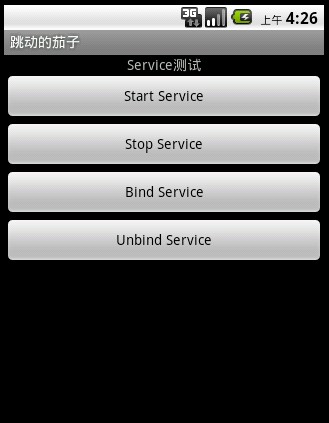
- Android学习小结之获取被启动的Activity传回的数据
- Android中判断有无可用网络的代码(是否是3G或者WIFI网络)
- Android客户端软件开发_13、多线程断点续传之多线程
- 使用Java代码在Android中实现图片裁剪功能
- Android app应用多语言切换功能实现
- android开发之方形圆角listview代码分享
- Android编程实现仿优酷旋转菜单效果(附demo源码)
- android开发教程之view组件添加边框示例
- Android开发之menu菜单
- Android客户端软件开发_10、下载模块的流程分析以及详细流程图等
- Android使用TextView实现无下划线超链接的方法
- Android中获得正在运行的程序和系统服务的方法
- Android实现蒙板效果
- Android 屏蔽和捕获Home键的示例代码
- Android编程实现获取新浪天气预报数据的方法
- Android仿今日头条APP实现下拉导航选择菜单效果
- android内存及内存溢出分析详解
- Android利用HorizontalScrollView仿ViewPager设计简单相册
- 详细讲解Android中使用LoaderManager加载数据的方法
- Android 解析XML 文件的四种方法总结
- 深入Android SQLite 事务处理详解
- Android横竖屏幕切换小结
- android当前apn的状态以及获取方法
- Android客户端软件开发_7、Android软件开发的思考
- Android开发学习路线的七大阶段
- Android实现断点下载的方法
- [Android开发从零开始].4.TextView控件学习
- Android自定义ViewPager实现个性化的图片切换效果
- Android开发之实现GridView支付宝九宫格
- Android中PopupWindow响应返回键并关闭的2种方法
Android开发入门之Service用法分析
本文实例讲述了Android中Service用法。分享给大家供大家参考,具体如下:
关于Service的讲解网上已经很多了,这里是关于自己通过写代码Service的一点体会 还有结合其他人对Service的一点总结
Service可以理解为一个隐形的Activity 但它又与Activity有些不同,首先Service是没界面,用户看不到 可交互的组件 级别是与Activity是差不多的
Service中定义了一系列和自身声明周期相关的方法:
onBind(...)是必须实现的方法,返回一个绑定接口给Service
onCreate(); 当Service第一次被创建时 由系统调用
onStart(...)当通过startService()方法调用启动Service时被调用
onDestroy();当Service不再使用,系统调用该方法....
本次代码分别有MainActivity,Java,MyService.java main.xml这几个重要文件 下面通过这几个文件对Service进行理解 见注释
老规矩 先开始布局 挺简单的 就是几个Button
<?xml version="1.0" encoding="utf-8"?> <LinearLayout xmlns:android="http://schemas.android.com/apk/res/android" android:orientation="vertical" android:layout_width="fill_parent" android:layout_height="fill_parent" > <TextView android:layout_width="fill_parent" android:layout_height="wrap_content" android:text="Service测试" android:gravity="center_horizontal" /> <Button android:id="@+id/startButton" android:layout_width="fill_parent" android:layout_height="wrap_content" android:text="Start Service" /> <Button android:id="@+id/stopButton" android:layout_width="fill_parent" android:layout_height="wrap_content" android:text="Stop Service" /> <Button android:id="@+id/bindButton" android:layout_width="fill_parent" android:layout_height="wrap_content" android:text="Bind Service" /> <Button android:id="@+id/unBindButton" android:layout_width="fill_parent" android:layout_height="wrap_content" android:text="Unbind Service" /> </LinearLayout>
布局效果图:

开始服务文件, MyService继承Service
public class MyService extends Service
{
final static String TAG = "MyService";
@Override
public IBinder onBind(Intent intent)
{
Log.i(TAG,"OnBind()......");
showInfo("Onbind()......");
return null;
}
// Setvice创建时被调用
@Override
public void onCreate()
{
Log.i(TAG,"onCreate()......");
showInfo("onCreate()......");
super.onCreate();
}
//当客户调用startService()启动Service时被调用
@Override
public void onStart(Intent intent, int startId)
{
Log.i(TAG,"onStart()........");
showInfo("onStart()........");
super.onStart(intent, startId);
}
@Override
public void onDestroy()
{
Log.i(TAG,"onDestroy()........");
showInfo("onDestroy()........");
super.onDestroy();
}
@Override
public boolean onUnbind(Intent intent)
{
Log.i(TAG,"onUnbind()........");
showInfo("onUnbind()........");
return super.onUnbind(intent);
}
public void showInfo(String str)
{
Toast.makeText(this, str, Toast.LENGTH_SHORT).show();
}
}
上面主要是Service中几个周期函数 这个MyService代表一个服务,当然在这里面我们在里面加什么实质性的东西,例如可以在
Onstart(...)函数里创建一个音乐播放器MediaPlayer 当服务被启动时播放音乐.....
你创建了Service 就跟你创建Activity一样 必须在Manifest里注册 下面开始注册
<!-- 增加的Service --> <service android:name=".MyService"> <intent-filter > <action android:name="com.study.android.action.MY_SERVICE"/> </intent-filter> </service>
服务就这样 注册成功。光注册成功还没有完成任务哦...... 还有启动服务,停止服务,绑定服务,解除绑定的服务
package com.study.android;
import android.app.Activity;
import android.app.Service;
import android.content.ComponentName;
import android.content.Intent;
import android.content.ServiceConnection;
import android.os.Bundle;
import android.os.IBinder;
import android.util.Log;
import android.view.View;
import android.view.View.OnClickListener;
import android.widget.Button;
import android.widget.Toast;
public class MainActivity extends Activity {
final static String ACTION = "com.study.android.action.MY_SERVICE";
private Button startButton,stopButton;
private Button bindButton,unbindButton;
@Override
public void onCreate(Bundle savedInstanceState) {
super.onCreate(savedInstanceState);
setContentView(R.layout.main);
startButton = (Button)findViewById(R.id.startButton);
stopButton = (Button)findViewById(R.id.stopButton);
bindButton = (Button)findViewById(R.id.bindButton);
unbindButton = (Button)findViewById(R.id.unBindButton);
// 开启服务
startButton.setOnClickListener(new OnClickListener()
{
@Override
public void onClick(View v)
{
// 启动服务
startService(buildIntent());
}
});
//startButton按下后 周期函数执行顺序 onCreate()----->onStart()
/******************************************/
// 停止服务
stopButton.setOnClickListener(new OnClickListener()
{
@Override
public void onClick(View v)
{
stopService(buildIntent());
}
});
//stopButton按下后 周期函数执行顺序 onDestroy()
/******************************************/
// 绑定服务
bindButton.setOnClickListener(new OnClickListener()
{
@Override
public void onClick(View v)
{
bindService(buildIntent(),conn,Service.BIND_AUTO_CREATE);
/*第三个参数:如何创建service 一般是制定绑定时自动创建*/
}
});
// bindButton 被按下后(当前服务已经stop掉)周期函数执行顺序 onCreate()------->onBind()
/******************************************/
// 接触绑定Service
unbindButton.setOnClickListener(new OnClickListener()
{
@Override
public void onClick(View v)
{
unbindService(conn);
}
});
//unbindButton按下后 周期函数执行顺序onUnbind()------->onDestroy()
}
// 连接对象
private ServiceConnection conn = new ServiceConnection()
{
@Override
public void onServiceConnected(ComponentName name, IBinder service)
{
Log.i("SERVICE","连接服务成功!");
showInfo("连接服务成功!");
}
@Override
public void onServiceDisconnected(ComponentName name)
{
Log.i("SERVICE","服务连接断开!");
showInfo("服务连接断开!");
}
};
public Intent buildIntent()
{
Intent intent = new Intent();
// 设置Intent属性 注意:这里action属性要与Manifest里服务对应
intent.setAction(ACTION);
return intent;
}
public void showInfo(String str)
{
Toast.makeText(this, str, Toast.LENGTH_SHORT).show();
}
}
更多关于Android相关内容感兴趣的读者可查看本站专题:《Android Service组件使用技巧总结》、《Android编程之activity操作技巧总结》、《Android资源操作技巧汇总》、《Android文件操作技巧汇总》、《Android操作SQLite数据库技巧总结》、《Android操作json格式数据技巧总结》、《Android数据库操作技巧总结》、《Android开发入门与进阶教程》、《Android视图View技巧总结》及《Android控件用法总结》
希望本文所述对大家Android程序设计有所帮助。
- 上一篇文章: Android利用ObjectAnimator实现ArcMenu
- 下一篇文章: 安卓Android Context类实例详解
- android实现图片反转效果
- android 为应用程序创建桌面快捷方式技巧分
- Android开发笔记之:AsyncTask的应用详解
- Android相册效果(使用C#和Java分别实现)
- Android自动测试工具Monkey
- Android开发退出程序的方法汇总
- android 触屏的震动响应接口调用方法